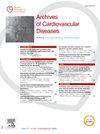Mesp1和Hes1相互作用控制早期心脏祖细胞的分化
IF 2.3
3区 医学
Q2 CARDIAC & CARDIOVASCULAR SYSTEMS
引用次数: 0
摘要
心祖细胞(CPs)在原肠胚形成早期出现。CPs表达转录因子Mesp1,并参与所有心脏区域。CP规格的改变或迁移导致先天性心脏缺陷(CHDs)影响1%的活产婴儿。我们发现Mesp1是早期心血管规范和分化的主要调节因子(Lescroart等人,Science 2018;Lin等人,Nat Cell Biol 2022),最近发现了转录抑制因子Hes1在CP部署中的关键作用(Rammah等人,Circ Res 2022)。确实,Hes1缺失会导致CHDs导致胚胎死亡。有趣的是,Mesp1谱系中的Hes1条件缺失重现了在Hes1缺失胚胎中观察到的心脏缺陷。目的探讨Mesp1与Hes1可能的相互作用,探讨早期CP规范的机制。方法采用荧光原位杂交技术(RNAscope)检测小鼠体外原肠胚模型、原肠胚和小鼠胚胎中Mesp1和Hes1基因的表达水平和表达模式。在Mesp1功能获得(GOF) mESC细胞系上进行RNAseq和Chip-seq实验。在原肠腺样体培养期间进行ScRNAseq分析。结果小鼠胚胎的rnascope显示Hes1在原肠胚形成过程中的差异表达。Hes1在FHF祖细胞中高表达,而在SHF祖细胞中开始下降。使用Mesp1 GOF mESCs的RNAseq和Chip-seq数据显示Mesp1下调Hes1。使用Mesp1突变胚胎,我们发现Hes1在中胚层中的表达增加,支持之前的数据。类胃液的ScRNAseq显示,在CP亚群中Mesp1和Hes1共表达。我们用RNAscope重现了这些结果,并在不同的CPs中发现了相似的表达模式。Hes1在Hand1+ FHF祖细胞中表达,而在Foxc2+ SHF祖细胞中表达下调。这些结果验证了我们的体内和体外模型,并指出Hes1在早期心脏发育中的作用,这是尚未报道的。结论Mesp1-Hes1相互作用在早期CP规范的调控中起重要作用。本文章由计算机程序翻译,如有差异,请以英文原文为准。
Mesp1 and Hes1 interplay controls early cardiac progenitor cell specification
Introduction
Cardiac progenitors (CPs) arise early during gastrulation. CPs express transcription factor Mesp1 and contribute to all cardiac territories. Alteration in CP specification or migration leads to congenital heart defects (CHDs) affecting 1% of live births. We uncovered Mesp1 as a master regulator of early cardiovascular specification and differentiation (Lescroart et al., Science 2018; Lin et al., Nat Cell Biol 2022), and recently identified a crucial role for transcriptional repressor Hes1 in CP deployment (Rammah et al., Circ Res 2022). Indeed, Hes1 deletion results in embryonic lethality due to CHDs. Interestingly, Hes1 conditional deletion in Mesp1 lineage recapitulates the heart defects observed in Hes1 null embryos.
Objective
To investigate the mechanism of early CP specification by exploring Mesp1 and Hes1 possible interplay.
Method
In vitro mouse gastrulation model, gastruloid and mouse embryos were used to reveal expression levels and patterns of Mesp1 and Hes1 using fluorescent in situ hybridization technique, RNAscope. RNAseq and Chip-seq experiments were performed on Mesp1 gain-of-function (GOF) mESC line. ScRNAseq analysis was performed during gastruloid culture.
Results
RNAscope on mouse embryos revealed differential Hes1 expression during gastrulation. While Hes1 expression is high in FHF progenitors, starts to decline in SHF progenitors. RNAseq and Chip-seq data using Mesp1 GOF mESCs has shown downregulation of Hes1 by Mesp1. Using Mesp1 mutant embryos, we showed increased Hes1 expression in mesoderm supporting the previous data. ScRNAseq on gastruloids revealed coexpression of Mesp1 and Hes1 in CP subpopulations. We reproduced these results with RNAscope and uncovered similar expression patterns in different CPs that of embryos. Hes1 expression is detected in Hand1+ FHF progenitors and downregulated in Foxc2+ SHF progenitors. These results validate our in vivo and in vitro models and point out a role for Hes1 in early heart development that has not been reported.
Conclusion
Our data strongly support a role for Mesp1-Hes1 interplay in the regulation of early CP specification.
求助全文
通过发布文献求助,成功后即可免费获取论文全文。
去求助
来源期刊

Archives of Cardiovascular Diseases
医学-心血管系统
CiteScore
4.40
自引率
6.70%
发文量
87
审稿时长
34 days
期刊介绍:
The Journal publishes original peer-reviewed clinical and research articles, epidemiological studies, new methodological clinical approaches, review articles and editorials. Topics covered include coronary artery and valve diseases, interventional and pediatric cardiology, cardiovascular surgery, cardiomyopathy and heart failure, arrhythmias and stimulation, cardiovascular imaging, vascular medicine and hypertension, epidemiology and risk factors, and large multicenter studies. Archives of Cardiovascular Diseases also publishes abstracts of papers presented at the annual sessions of the Journées Européennes de la Société Française de Cardiologie and the guidelines edited by the French Society of Cardiology.
 求助内容:
求助内容: 应助结果提醒方式:
应助结果提醒方式:


